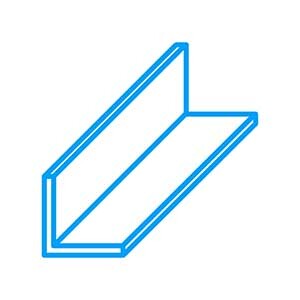Angle steel overview
Angle steel, also known as steel angle, is an essential Component in steel construction and mechanical engineering. These profiles are available in various dimensions and shapes and are mainly made from mild steel such as S235JR or S355J2. Angle steel offers an excellent combination of strength, versatility and cost-effectiveness, making it a preferred choice for a variety of applications.
Variants and dimensions
Angle steel is available in two main varieties: isosceles and isosceles. Both types have specific advantages and possible uses. Isosceles angle steel has legs of equal length, while isosceles angle steel has legs of different lengths, providing additional flexibility in construction.
Isosceles angle steel (S235JR):
- Dimensions: 20x20x3 mm to 100x100x11 mm
- Weight: 0.88 kg/m to 16.40 kg/m
Isosceles angle steel (S235JR):
- Dimensions: 30x20x3 mm to 150x75x9 mm
- Weight: 1.11 kg/m to 15.30 kg/m
Applications
Angle steel is used in numerous areas including:
- Construction industry: For strengthening building structures, bridges and other structures.
- Mechanical engineering: For the production of machine frames and housings.
- Furniture industry: For shelves, tables and other furniture constructions.
- Transportation: In trailers, trucks and other vehicle designs.
Advantages
- High strength: Angle steel offers high load capacity and structural stability, making it ideal for load-bearing applications.
- Versatility: It is easy to cut, drill and weld, allowing easy customization to specific project requirements.
- Cost efficiency: Compared to other building materials, angle steel offers excellent value for money.
- Corrosion resistance: Especially in galvanized form, it offers a high level of protection against rust and weather influences.
Quality standards
Angle steel is used, among other things: Manufactured according to the standards listed here Guarantee quality and dimensions. This includes:
- EN 10025: Technical delivery conditions for structural steels.
- EN 10056: Dimensions and permissible deviations for isosceles and isosceles angle profiles
Conclusion
Angle steel is an indispensable element in the modern construction and engineering industry. His good Strength, versatility and cost-effectiveness make it an optimal choice for numerous applications. Whether for large construction projects or small DIY projects, angle steel offers the necessary stability and flexibility to meet the requirements.

